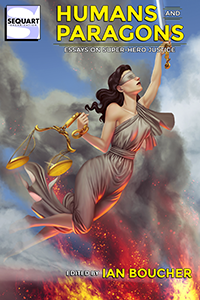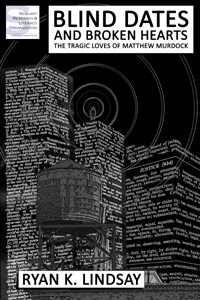Spot. The Spot. An insignificant speck upon the Spider-Man rogues gallery whose unique powers and interesting concept are overshadowed by his silly costume and bland personality traits, mostly attributed to not being utilized much by writers. He was the standard C-list villain in comics who could easily be thrown under the bus as hero canon fodder.
Then Daredevil happened.
In Daredevil #19 we have seen the evolution of a character from an overlooked and underused C-list villain to something truly terrifying.
For those of you who are unfamiliar, the Spot is a villain in Spider-Man’s rogue’s gallery with the ability to create warps holes in space to allow him to teleport anything from one point to another instantaneously. Each warp hole would be in the form of a spot on a surface or even in the air. Often he would torment Spidey as a common thief who could create many of these holes to an alternate dimension and pummel Spider-Man from many angles. Among villains, he was one of the few that could actually overcome the precognitive spider-sense with ease.
While he often overlooked in stories in favor of Spidey’s other nemeses, he did end up playing a major role in the overarching plot of the 1994 Spider-Man series, despite only appearing in a handful of episodes (only one of which under his villainous moniker.) In fact, after the creation of his portal science, Spot, formerly known as Dr. Jonathan Ohm, seemed to vanish from the series. Rather, his portals were seen as a means of “killing off” Mary Jane as to emulate the famous Gwen Stacy bridge scene. The portals would pop up throughout the series and create issues for Spider-Man, even up until the series finale.
And that was all Spot was seemingly good for.
As is the case with most villains who become C-list, despite whatever unique abilities they may have, Spot became increasingly more incompetent when confronted by his heroic foil. It got to a point where he simply existed and was hardly being utilized except to be a squash fight for other heroes to build credibility, even going so far as to be one of the inaugural members of Spider-Man’s Legion of Losers. That was even what I assumed was the case for the Spot when Mark Waid took over Daredevil in 2011.
I was dead wrong.
Over the course of 19 issues, Mark Waid has created a story of Matt Murdock trying to reclaim some semblance of happiness despite his often-depressing life as a vigilante. The series had felt fun and upbeat for several issues as Daredevil battled villains that, while never traditionally being Daredevil villains, seemed to fit right into the mythology and complimented Matt’s own abilities well. We saw Daredevil face off against Klaw, Mole Man, and the aforementioned Spot and it all felt right.
You could “see” Daredevil’s perspective of the world and got an otherworldly vibe from Klaw and Spot. You could see a unique connection between Daredevil and Mole Man as they confronted each other in blind combat under the Earth. It was far removed from Daredevil’s usual fair of fighting street crime and zany super villains like Stilt Man and Purple Man. But over time, the depression of superheroics and the melodrama of Matt Murdock’s life poked its head in once more.
Slowly, over the course of several issues, Matt’s sanity had slowly been put into question. His best friend, Foggy Nelson, was debating on whether Matt was truly all right or whether he had finally snapped. Things would appear and disappear in places that they should not have been. Matt himself even suddenly vanished in one adventure, appearing again in Latveria with the general assumption being that Doctor Doom or his men had performed the deed as Daredevil was incarcerated upon his reappearance.
It was a world in shambles for Matt putting him through a gauntlet of seemingly unconnected events that hit him where it hurt most. Even the remains of Matt’s dead father were not sacred as they were seemingly rediscovered despite being lost and given to Foggy just to perpetuate Matt’s possible insanity.
And who was the perpetrator of this carefully planned plot to destroy Daredevil? The Spot, of course. A man whom Daredevil defeated in the first issue of Mark Waid’s run in an embarrassing defeat at the hands of the blind vigilante during a botched assassination. Now, however, the Spot was no longer the bumbling fool with a polka dotted Dalmatian style costume. Now ,the Spot was a man in the pitch-black costume with demonic face. He was transformed into something physically and mentally into a beast of pure evil. This is no longer the Spot, but rather Coyote.
It is an interesting thing to me when I see villains transform themselves beyond what they had been prior. We saw this with another Daredevil villain known as Mr. Fear during Brubaker’s run on the title as well as with Catman during Gail Simone’s Villains United mini-series and the subsequent Secret Six series. It is an interesting thing because it follows the same logic of a heroic transformation.
Often times, when many heroes find themselves in a low point in their lives, they will transform themselves by looking within to find what makes them a symbol of good. They find what makes them worthy of the title hero and it transforms them into something that is capable of facing coming challenges. The hero breaks down what is essential to them and brings that out.
Villains do the same process, but with much more terrifying results with the most common catalyst being vengeance. Mr. Fear found what it meant to be terror. Catman found out what it meant to be the hunter and the embodiment of the lion.
The Spot? He found out what it meant to be an otherworldly creature, like he truly was. In a single act he became more than a C-lister in concept and became a monster worthy of the title “villain.” A title that is needed in all forms of fiction, particularly in comics, as the villains that strengthen and temper the hero into a greater figure for the audience to emulate. Captain Cold said it best, “a hero is only as good as his villains.”
Personally, I hope Spot, now going by the moniker Coyote, will continue to thrive as a major Marvel villain, because he has shown in just a short time what kind of a haunting menace he can be when he can be anywhere at any time.























































